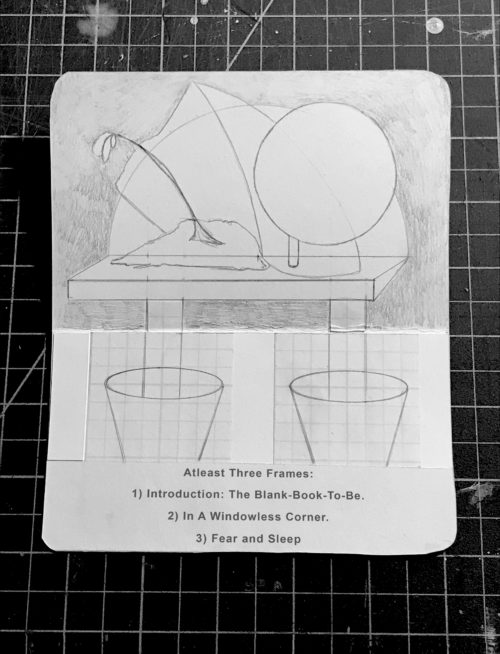Jim Grilli: At least Three Frames: 1) Introduction: The Blank-Book-To-Be. 2) In A Windowless Corner. 3) Fear and Sleep
1 February – 17 March 2019

Opening reception Friday, 1 February from 6 – 10 pm
Performances:
Saturday, 9 February at 3pm
Saturday, 9 March at 3pm
Marginal Utility is proud to present At least Three Frames: 1) Introduction: The Blank-Book-To-Be. 2) In A Windowless Corner. 3) Fear and Sleep, a solo exhibition by Philadelphia-based artist Jim Grilli.
At least Three Frames is the fourth addition to an ongoing series of installations and performances that the artist has been working on since 2015. Each installment explores the relationships between texts and objects, writing and performativity, as well as artistic production and political engagement. The present exhibition includes sculptures, drawings, handwritten notes, and acquired items that are the products of Grilli’s open-ended approach to juxtaposing disparate materials, themes and processes. Each carefully placed element serves as one manipulable component of an environment that is both an intuitive visual composition and the site of a participatory performance. The appearance of the exhibition will be considerably altered by the performance as the artist interacts with, adds to, and invites the viewers to intervene in the space during specified periods of time. The ultimate goal is to trouble The Frame as described in the following letter:
To Whom It May Concern:
Whenever I am working on a picture and it becomes too pictorial I consider throwing it away. In other words, if the project becomes too coherent it is a failure. Despite accepting having failed, I can never bring myself to dispose of the picture. I may dream of being rid of the offensively successful thing for months, but for some reason I remain unable to destroy the materials that comprise it.
The concept of “being rid” is undoubtedly curious. I always suspected that wishing oneself rid of X, for example, was a waste of energy regardless of the use, value, or appearance of the object in question. The act of fantasying subtraction or extrication from something struck me as misguided. In short, until sitting down to draft this letter I did not have language capable of describing “absence”.
The Frame is the heart of the matter: the plane of inclusion or exclusion. Until recently I assumed that ridding myself of an object would require its movement outside The Frame, but now I think the opposite might be true. What if freedom (ridding yourself) necessitates keeping it inside The Frame? What if exclusion from The Frame is mere avoidance and therefore counterproductive? Perhaps the task is to increase one’s tolerance for The Frame being crowded.
Anxiety leads to purging an item from The Frame because it challenges the subject’s notion of The Frame. How The Frame is seized, the shape it takes while accommodating all available stimuli, is reflected in the subject’s private understanding of the new object that is the outcome of this process. The new object is simply the unaltered old one after it has been integrated into The Frame that, as a result, has changed. This act marks the site of a performance shared by the participants who come to know its form. For example:

Of course, The Frame is only mutual curiosity between the internal and the external as they see and shape each other. Thank you for taking a moment to read these comments. I apologize for my late response. Hopefully, I will remember to drop this note in the mailbox soon. I suppose I could have emailed you.
Regards,
![]()